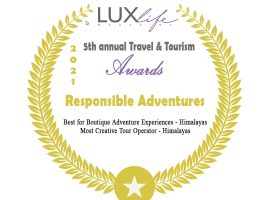A wedding in remote Nepal
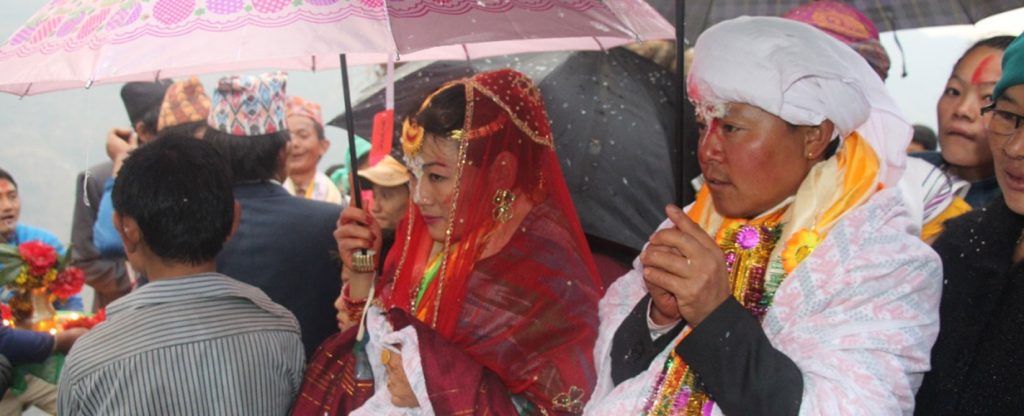
Attending a wedding in remote Nepal We recently concluded a trek to remote Sotang Village Municipality’s village to attend and financially support the wedding of our dear and longest-serving staff Chandra and his bride Manku Rai. We had planned it so our previous and new customers could experience cultural immersion by attending a wedding in Real Nepal ? away from the touristy places 99% of the visitors to Nepal go to. The whole wedding experience was planned for a week. The joining date of the trip coincided with Valentine’s Day. We had four overseas participants ? an Australian couple who have done two treks with Chandra; two Singaporeans ? one who has done several treks with the groom, and the other who has made three trips with us. The Journey to the Wedding. We had a long drive towards Salleri on the second day. We drove on a winding road along the Sun Koshi River until we reached Harkapur of Okhadhunga district, where we started ascending. Despite the relatively short distance and good road conditions, it took us longer than expected. Being stuck for forty-five minutes in a traffic jam in Kathmandu didn’t help. We had a team discussion and decided to stay at Patale for the night. Upon reaching Patale, we checked out the rooms, which were basic but neat and clean; we ordered some refreshing black tea and Dal bhat (Nepalese staple diet) for dinner. It was a cold but clear night at 2875 meters, with stars shining brightly as there were no light disturbances. We had an early night so we could have an early start. The following day was clear, and we took the wedding participants for a surprise view of Mount Everest and other giant Himalayan Peaks before breakfast. After that, we headed for Salleri, the district administrative centre for Solu Khumbu district; the jeep got refuelled. We left the blacktopped road a short distance after refuelling, and the bone-wrenching journey to Sotang began. However, the scenery made the rough drive somewhat bearable. It took us about three hours to reach the Dudh Koshi River before the last leg to Sotang Bazaar. The River was only made possible to cross from the previous winter with a temporary “bridge” built over it. The final 5 km was the most challenging part of the journey, where some passengers had to descend at a few places so the jeep could manoeuvre over steep dirt road sections. The 5km drive took us ninety minutes. Once we reached Sotang Bazaar, we went to our staff Sundar’s “hotel” to have our preordered lunch while our seven porters were busy offloading our camping gear from the jeep and divided it into equal loads. We had a two and half hour hike to Majh Kharka ? the groom’s village. The walk was relatively comfortable, with a small ascend for about forty-five minutes to the top of the hill. The trail then became short descents, undulating before we started a short climb to the groom’s home. Chandra eagerly awaited our arrival; his family members warmly welcomed us. Our porters arrived shortly after us; they and our support team got busy setting up our tents on the local “Youth Club grounds.” We were invited to dinner with the groom’s family, as they were ‘free’ before the wedding rush began the following day. Once our campsite was ready, we set our respective tents up and got ready for the evening. The Rai ethnic group and their traditions Chandra belongs to the Kirat ethnic group of the Rai and Limbu communities, with numerous clans and sub-clans. The Kirats are some of the first recorded people to have ruled Kathmandu in Nepal’s history. They practice a mixture of ancient animistic religions worshipping the forests, rocks, rivers, and everything to do with nature and some Hindu rituals. The most important part of their diet is pork ? every household rears a pig for special occasions. They also love their alcoholic drinks, namely Chang ? fermented grains, but millet is their grain of choice, which they drink instead of water and Rakshi ? distilled homemade liquor from fermented millet. Alcohol is consumed in all their essential rituals. Pre-wedding family dinner We went into the ‘kitchen’ of the family, where a fireplace is set in the middle with four poles on each corner ? an essential part of the Rai ethnic group’s traditions. Unique places are set for the elders according to their importance in the family. We were invited to sit with the family members and were served Rakshi ? their homemade liquor. Culture and traditions were explained to the guests. It appeared that their weddings were very well organized with various chores/duties assigned to a different set of people ? mostly all relatives. It starts with a guy who estimates the whole wedding budget; I jokingly called him the CFO, a team each for making Chang, Rakshi, purchasing, cooking, the sisters and female cousins were in charge or serving alcohol to all present ? they made sure everyone had plenty. So we had plenty to drink and a good dinner of pork curry and rice. We went to bed feeling relaxed after the consumption of rakshi despite the bone-wrenching ride that morning. Final preparation day We were woken up with an ayurvedic drink delivered to our tents. This drink is excellent as it has anti-inflammatory properties, provides exceptional energy, and gets rid of cancerous cells. One of our host’s cousins had kindly invited us for breakfast. The morning activities consisted of going for breakfast, having tea with another of our host’s cousins, and visiting the local school to watch a pig’s ritual killing before lunch. Our overseas guests were treated to an excellent and healthy meal prepared by our trekking chefs while we went for lunch at a relative’s home. The villagers are so hospitable and accommodating. We were invited to many of their homes for tea and meals; sadly, we couldn’t visit every house that welcomed us.
Upper Mustang trekking general information

Upper Mustang trekking – General information The Upper Mustang region lies in the Northern part of the Mustang district in Nepal. It used to be one of the famous trading routes between Nepal and Tibet. The people of Mustang practice Tibetan Buddhism and speak a Tibetan dialect. It once was an independent Kingdom from 1380 until it was annexed into Nepal in the 18th century. The people of Upper Mustang practice animal husbandry, trading, and some limited seasonal farming. Farming was always limited due to its position in the Trans Himalayas with a semi-arid climate. However, the receding glaciers have made it even more difficult to cultivate in this high land in recent years. So much so that some villages have been abandoned, and the inhabitants have migrated elsewhere: ironic for the place called Smon-Thang in Tibetan, which means fertile plain. For more details about Upper Mustang To reach Upper Mustang, one must travel northwards of the Kali Gandaki Valley, the most in-depth ravine globally, with Mount Nilgiri 7055 meters – 7134 meters and Mount Dhaulagiri 8167 meters, the seventh highest peak in the world to its South. The average altitude of the Mustang is around 4000 meters. The capital, Lo Manthang, is a walled city. Trekkers were only allowed to visit the Upper Mustang in 1992. Nepal government charges a special area permit of US$500 for ten days and $50 for every additional day in this area. A liaison office must also accompany the visiting international groups to keep close supervision to protect centuries-old local traditions and cultures. Due to this high permit fee, less than 1000 trekkers visit this region every year. Only the Bonafide Trekking companies of Nepal can obtain this special area permit. For more on Lo Manthang Lo Manthang is known for its high whitewashed mud-brick walls, Gompas, and the King’s five-storey palace. It is believed to have been constructed in the 15th century. There are four significant Gompas within the walled city. An average trekking duration depends on the number of stops made in various villages. However, you can do a comfortable 10-15 days round trip journey to Upper Mustang. It involves trekking on dry, dusty trails with several passes to go over to reach Lo Manthang. The road from Tibet already got Lo Manthang in 2001, and a fair-weather highway is under construction from Jomsom, the administrative headquarter of Mustang District. Due to road construction, locals have turned to ride motorcycles or horse riding. Upper Mustang is still mysterious and surreal. Please visit Upper Mustang while you still have a chance to discover its unspoiled beauty. We do organize a hassle-free trekking holiday to Upper Mustang. The King of Mustang, Jigme Paljor Bista, passed away on 16th December 2016, aged 86. This article is by Raj Tamang, Chief Experience Officer of Responsible Adventures. Check out our Trekking packages for Nepal, Bhutan, India, and Tibet.
Shamanism in Nepal Himalayas

Shamanism in Nepal A recent anthropological study shows that this is not a single universal Shamanism but multiple forms of Shamanism. The diverse types of mediumistic and Shamanistic practices support this argument in Nepal. Even though the nation’s specific ethnic groups can be linked with particular ceremonial and religious traditions, it is beneficial to think of these historic strands as part of the broader Hindu-Buddhist Shamanistic ritual structure. In addition, it is familiar with the hill communities that reflect Nepal’s compound cultural, geographical, and linguistic distinctness. Large sections such as “spirit mediumship,” spirit possession, and “shamanism” do not do justice to reflect the whole array of ways in which rituals are practised. In early 2019, I spent a few weeks with a Shaman in East Nepal around 2700 meters to learn more about Shamanism. The village and its never-ending terraces were occupied predominantly by Tamangs. The other Nepalese ethnic groups consisted of Sherpas, Sunuwar Rais, Chettris, and Brahmins in the lower hills. The Chettri Shamans share several essential traits common with shamans of other ethnic groups, including the utilization of ritualistic paraphernalia and drums. However, the regions “Kul-Dhamis (lineage mediums) serve primarily as vehicles of the Chettri “Kul” patrilineage, and those are different from the ritual practitioners of the other ethnic groups. Dhami and Jhakri are often used as a single term in Nepal. However, Dhami Jhakri is commonly used conversely to refer to the ceremonial practitioners who are believed to have the ability to manifest local spirits and deities. The emphasis on metaphysical personification’s embodiment differentiates these practitioners from other religious gurus who either do not desire or cannot connect with spirits. In more extensive anthropological terms, Dhami generally refers to ‘spirit mediums’ or ‘oracles.’ In contrast, Jhakri is usually translated in English as ‘shaman.’ A variant of a ‘Shaman is Bombo, in the Tamang dialect. In local practice, a Dhami is a person who accomplishes a specific ritual objective. The hyphenated Kul and Jhakri refer to how this purpose is fulfilled; possession by the Kul-Deuta (ancestral deities) in the former instance; while utilizing the Shaman’s equipment helps gain access latter. The insistence on the technique and specific ritual accessories suggests a relevant difference between the Jhakri and Dhami masters. The significance of the Shamanistic accoutrement as a differentiating indication becomes even more credible. The term Jhakri not only refers to the human practitioner but also characterizes the Shaman’s protective deity. The ban(forest)-jhakri is a small creature covered in hair and lives in the surrounding forest. It is believed that it is equipped with a drum and shamanistic equipment. The Landscape of the Spirits In the hills of Nepal, it is believed that people and spirits walk the same passage. The deities and ghosts reside in the surrounding forests and hills. Faith healing is essential to define society, body, and spirit interconnection. Health does not only involve well-being at an individual and physical level. It means one’s hereditary, social, and cosmic affiliation advances as a whole in harmony. Occurrences of ill health amongst the Nepalese hill colonies are epitomized onto the encompassing landscape regularly. People fall ill when they pass through the domain of the spirit beings unknowingly. Then, the angry spirit attacks the trespasser by causing illness and invades his daily life. The shamans and mediums can access knowledge and heal the patients due to their association with specific deities or local spirits. It is believed that these practitioners can embody these spirits or gods in a special ritual. The lineage mediums are exclusively male, while shamans can be either male or female. Some ethnic communities believe those female shamans can be even more powerful than their male counterparts. The lineage medium only performs on certain ceremonial occasions and does not need unique accessories embodied by the lineage deities. The primary prerequisite is that he fasts while preparing himself ritually to serve as a vehicle for his gods to represent him. The possession of the Kul-Dhami always takes place inside the house close to a designated space to house the lineage deities. Two or more other mediums accompany the Kul-Dhami. Once possessed, he will proceed to utter clairvoyant proclamations to the assembled members of the family. The members of the family may and often do ask questions to the possessing deities. Generally, the main questions asked on occasions such as this address family matters, the concerns relating to the possible outcome of some disputes, the livestock’s wellbeing, matters concerning the crops, and other daily issues. The lineage mediums can also perform to correct specific causes of misfortunes of individuals or collective healing rituals. A compound set of affiliations integrates the household’s symbolic and dimensional properties. The management of the family’s domestic spaces, rituals, and the accurate definition of the cumulative existence as members of a single patrilineage are crucial in the lineage mediums’ practice. By comparison, the shamans’ rituals are not caste or lineage-specific. The Chettri shamans and those from other ethnic groups and communities can perform a curing ritual for their caste, ethnic group, or lineage as they are for someone from another society. The rituals of the Dhami-Jhakri unite the various societies into an extensive network of characteristics and experiences. The sound of the Shaman’s beating drum echos across the valley through the night while reinforcing these connective communities. One of the defining aspects of the Shaman all over Nepal is the standard shamanistic devices used to obtain admittance to protective spirits and battle or restrain ghosts, spirits, and witches. The equipment consists fundamentally of a ‘dhyangro’ (drum), a unique attire, head-dress, belts of bells tied around the waist or worn across the shoulders; some shamans have included the latest equipment in bicycle chains. The Shaman usually performs alone, and the centre of their restorative rites are typical of a personal and familial instead of collective nature. While in marked difference to the Kul-Dhami, the spot where the Dhami-Jhakri carries out his rites is undefined and is circumscribed primarily based on the situation. Integrating Spirits
Schools In Remote Villages of Nepal
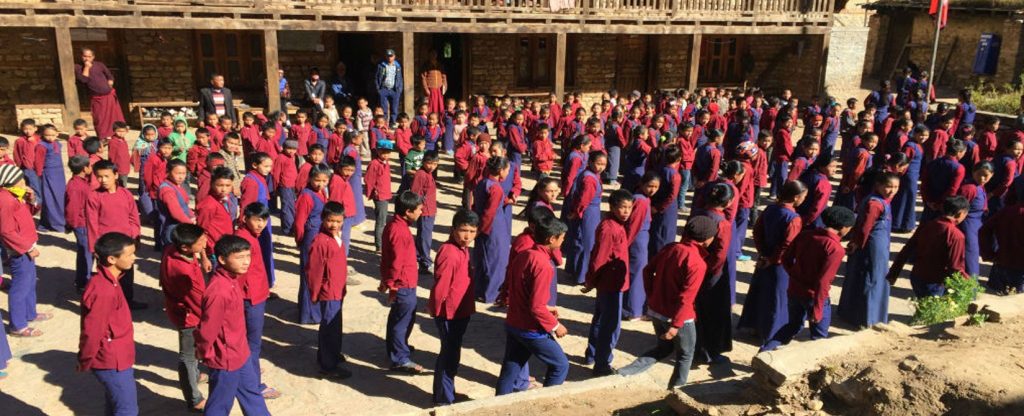
Schools in remote villages of Nepal. More and more schools are being opened all over Nepal, as people know the importance of education. The government builds most schools. However, some children from neighbouring villages walk for a few hours to and from a school in a “nearby” village. Many villages have taken the initiative to start schools on their resources or ask trekkers to help establish a school in their village if they are on the trekking routes. If a village is fortunate enough to be on a trekking route, they ask for donations from passing trekkers to finance their needs, such as paying the teachers’ salaries. The government takes over schools like this after a few years; however, due to the limited number of teachers provided, the village committees give the salary of the extra teachers they have hired. The Tapriza School. On a recent visit to a very remote district of Dolpo, we came across some interestingly different trends in schools of that district. We visited The Tapriza School. The first thing that caught my eye was the children’s uniforms – they were dressed in traditional Tibetan dresses. Most Government school uniforms in Nepal consist of dark blue trousers and light blue shirts for boys, while the girls wear dark blue skirts and light blue shirts. There were a few interesting differences practised in this school compared to the rest of the nation. First, it was the only high school in the district. The other schools in this district had only primary-level education. Second, all the students had various Non-Governmental Organizations (NGOs) find sponsors to continue their further studies in Kathmandu if they weren’t sent to The Tapriza School. Third, this school has a proud record of one hundred per cent of its students finishing the school leaving certificate (SLC) with a First Division (60 per cent or higher) mark since it was inaugurated in 1998. History of The Tapriza School In the late nineties, two Swiss students came to do research. The villagers approached them to ask for help in establishing a school. It caught the Swiss students’ attention; they went back home to spread the word. As a result, Tapriza NGO was founded in 1997 to help raise funds for the school. They even brought a few villagers to Switzerland to speak to potential donors for the school. The visit proved to be a success, and they made a trip to the United States to raise funds for the school’s construction. The mural explains how the school started. The uniqueness of the school. When we reached the school, the assembly was taking place. We noticed some building construction as some of the school buildings collapsed during the April 2015 earthquake. The students were smartly uniformed in traditional dress, as mentioned earlier. The school manager was kind enough to speak to us. They even had a Bon (an ancient religion that predates Tibetan Buddhism) Monastery within the school’s compound. We were informed that Bon monks and Nepali English languages teach Tibetan and religion. We visited the monastery, and I asked about the unfamiliar murals painted on the walls. On the right side of the wall next to the entrance, the paintings told the tale of the two Swiss students visiting the area and the villagers asking for donations in Switzerland and the United States. On the left side of the wall next to the door was a mural of how their ancestors dressed and lived and how the youths dressed these days. The manager informed us this was to remind the students of their rich roots. I found this great value to educate and tell the students about their heritage and how it was founded, like in most high Himalayan regions of Nepal. The schools open from March to the end of October and are closed for the winter from November through February. Check out our Trekking packages for Nepal, Bhutan, India, and Tibet.
Pilgrimage sites of Nepal
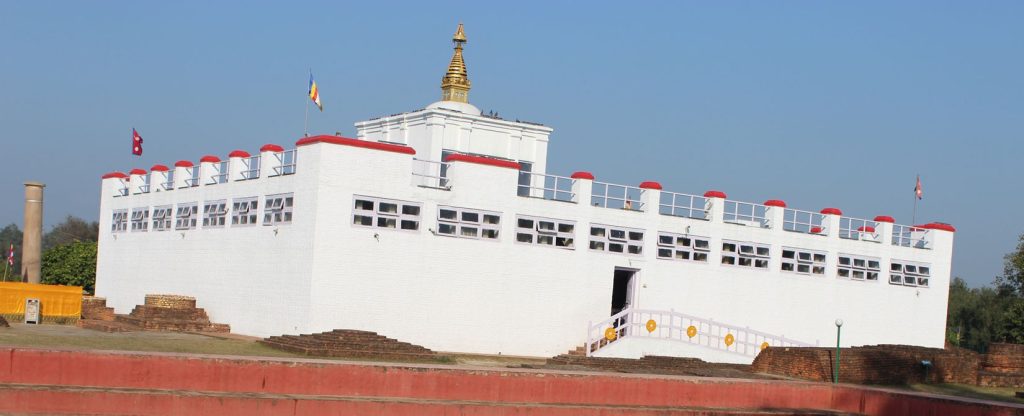
Pilgrimage Sites of Nepal Nepal is known for its natural beauty and a melting pot of two of the world’s oldest religions – Buddhism and Hinduism. Some of the most ancient religious sites exist here with a history that dates back to several thousand years. Buddhists and Hindu pilgrims come to find salvation in these holy sites. Some of these sacred sites are set amongst breathtaking views of the snow-capped Himalayan peaks, which involve trekking along deep valleys. It can be an out-of-this-world experience that is both physically and spiritually rewarding. Nepal is a land steeped in mythology and legends. It is home to numerous Buddhist and Hindu pilgrimage sites. The Himalayas have always been considered the abode of gods. The Hindu scripture Skanda Purana cites, ” In a hundred ages of the gods, I cannot explain the glories of the Himalaya to thee.” It is also said that the Himalayas’ sight cleanses the sins of humankind while the morning dew is dried up by the morning sun. The Hindu pilgrimage sites have been divided into four sections known as Char Dham ( Four Abodes), Pashupati Chettra, Mukti Chettra, Ruru Chettra, and Baraha Chettra. These abodes are spread in different parts of the country in all four directions; East, West, North, and South. Similarly, the devotees of Vishnu, Shiva, and Kali or Bhagawati, known as Vaishnava, Shaiva, and Shakti, go to the respective shrines to worship. The Hindus and Buddhists have lived side by side in harmony for a few thousand years. Numerous temples, shrines, and monasteries are sacred to Buddhists and Hindus. Pashupatinath Temple is considered the holiest for the Hindus in Nepal. Lumbini, the birthplace of Lord Buddha, is located in the Terai region South West of Kathmandu. It is considered one of the most sacred places for Buddhists. The Temple of Muktinath is situated in the trans-Himalayan district of Mustang. It is dedicated to Lord Vishnu and Avalokiteshwar; Buddhists and Hindus revere this site. Several monasteries and caves where Padmasambhava or Guru Rimpoche are believed to have meditated before introducing Tantric Buddhism to Tibet. Gosainkunda Lake is tucked away in a serene location in the Langtang region at 4380 m and is dedicated to Lord Shiva. There are Bonpo monasteries in the Mustang and Dolpo districts of Nepal. Bonpo predates Hinduism and Buddhism. It is a practice of animism and shamanism. The temples, monasteries, shrines, and lakes are flocked by many pilgrims on specific religious festivals and occasions. For example, the Temple of Pashupatinath draws hundreds of thousands of pilgrims from Nepal and India during the Shivaratri Festival. The Pashupatinath temple and two Buddhist stupas, Swayambhunath, Boudhanath, and Lumbini, are UNESCO World Heritage sites.
The People Of Sikkim their culture and religions

The People Of Sikkim have their culture and religions. Sikkim has a blend of diverse communities, cultures, religions, and customs. Sikkim is an excellent example of harmonious living between people from different areas and regions. The people of Sikkim are known as Sikkimese. The leading communities in Sikkim are the Lepchas, Bhutias, and Nepalese. However, some Plainsmen have settled here, as they own businesses in the urban areas and are in government service. Sikkim’s development with roads, bridges, buildings, and hydropower saw an influx of migrant labourers from the plains and Nepal. We will be discussing the three cultural communities and their lifestyles. The Lepchas The Lepchas are believed to be the original inhabitants of Sikkim. They resided in Sikkim long before the migration of Bhutias and Nepalese. The Lepchas’ original religion was of the Mune or bone faith, similar to pagans. They used to worship spirits of the mountains, rivers, and forests. Later on, they converted to Buddhism and Christianity. The earlier religion could explain why these people prefer to live in a healthy environment. The Lepchas form only 13% of Sikkim’s total population; they are concentrated in Sikkim’s central part. The prominent places of the Lepchas are Lachen, Lachung River valleys, and Dickchu valley. They lead an honest life. The men wear a dress known as Pagi, a cotton dress in strips. The women wear a two-piece dress. They speak the “Lepcha” language, which isn’t widely used. They are very good at archery. The Bhutias The Bhutias are people of Tibetan origin. These people migrated to Sikkim sometime during the 15h century from the Kham province in East Tibet. They mostly populate the Northern part of Sikkim. They speak the “Sikkimese” language, which is from the Tibeto Burman group. The Bhutia population dominates in large numbers in the villages, compared to the Lepchas. The Bhutia houses are rectangular and are called “Khin” in their language. The men’s traditional dress is called “Bakhu,” a loose cloak of a garment with full sleeves. The women folk wear a silk blouse called a “Honju” inside a loose gown type garment. The garment can be cotton, silk, or brocade. Sikkim has incorporated the Bhutias’ religion. They constitute about 16% of the total population of Sikkim. The Bhutias regard priesthood as both their academic as well as spiritual choice. The Nepalese The Nepalese came into Sikkim long after the Lepchas and Bhutias. They migrated to Sikkim in hordes and rapidly emerged as the leading community. The Nepalese constitute 67% of the total population of Sikkim. They started terrace farming in the state. The Nepalese community began cardamom, a critical cash crop cultivation. The Nepalese are divided into castes for the Hindus, such as Brahmins, Chettris, Damai, Kami, and Sarki, while other ethnic groups such as Gurungs, Tamangs, Rais, Limbus, and Magars have their clans and sub-clans. Most of this population practice Hinduism, while the rest practise Buddhism in some ethnic groups. They speak the Khas language, somewhat similar to Hindi and are understood and communicated throughout Sikkim. The men wear a traditional dress consisting of a long double-breasted tunic below the waist known as Daura and a long pair of trousers known as Suruwal. The women’s traditional clothing comprises a double-breasted blouse known as “Chou Bandi Cholo” and either a saree or sarong; they often use a shawl to wrap themselves. Check out our Trekking packages for Nepal, Bhutan, India, and Tibet.
The People Of Darjeeling, their culture and religions

The People Of Darjeeling, their culture and religions. The Lepchas and Rongpas (people from the lower elevations) were the Darjeeling Hills’ original inhabitants. They are Tibeto Burman in appearance, although their origin is obscure. The higher population of the people in the Hills is The Gorkhas. They are industrious, enterprising, and speak several languages/dialects. They join the British and Indian armies as a career. They are short with oriental features of Nepalese origin and are known for their bravery, just like their cousins from Nepal who are well known the world over. Several of them have been decorated with the Victoria Cross – the highest award in the United Kingdom. The Gurkha’s Khukuri is a well-known weapon. Amongst the Nepalese population of Darjeeling is also the Sherpas. They are renowned for their courage, surefooted, and skills at high altitudes. They have made immeasurable contributions to mountaineering in the Himalayas. The other ethnic groups are The Newars, Tibetans, Bhutias, Sikkimese Bhutia, Dukpas, and Bengalis. Nepali Folk dances The Nepalese have a rich folk culture. The hills and valleys are a treasure house of songs and dances of the hill folk. They are a very musical lot with a lyrical, rhythmic mind and heart that doesn’t hesitate to break into a song and dance when the moment to celebrate arises. Their environment, consisting of the Majestic Himalayan Peaks, lush green hills, forests, and valleys, has influenced their religion, including folk songs and dances. The two major religions of Hinduism and Buddhism appear to have shaped the Nepali culture of its vibrant folk songs and dances to live side by side. The Nepalese folk songs and dances are influenced by ancient cave paintings, religious rites, and devotional songs. An Early form of dances and folk songs was attributed to the god, goddesses, and Hindu and Buddhist religions’ deities. These songs and dances were impressions of sacred dances performed to appease the deities and ward off evil spirits. Languages The dominant languages in Darjeeling are Nepali, Hindi, Bengali, and English. Bengali is the state language of the plains. Refugees and some other tribal people speak Tibetan. Religions Hinduism, Buddhism, Christianity, and to some extent, some Islam remain the predominant religions of Darjeeling. Food and Drinks You can pamper your taste buds with exotic but homely food and discover a mosaic of cultural delicacies while satiating your gastronomical needs. Whether it is the ubiquitous momo or thukpa, whose fabled taste has transcended across the Himalayas along with the migrant Tibetans, or the dishes with lemongrass from south-east Asia, Darjeeling has the best to offer you. Momo Momo is meat dumplings, either steamed, pan-fried, or deep-fried, accompanied by a bowl of clear soup and achaar (spicy sauce). One can also order vegetable momo, where cabbage and other vegetables replace the meat. Thupka Tibetan noodle soup consists of mixed with egg/meat and vegetables. Shyaphalay Shyaphalay is Tibetan bread that is stuffed with meat and deep-fried. It is served with a spicy sauce to dip in. Aludum This potato dish is an adaptation of the Indian recipe, and now the residents of Darjeeling can’t live without it. Tibetan tea It is made from tea leaves, brick, salt, and butter and churned to mix it well. Well-made butter tea can taste like soup. Tongba Tongba is made from fermented millet that is put inside bamboo. Hot water is poured into the bamboo container, and the liquid is sipped through a bamboo straw after a few minutes. It is a favourite amongst many during the cold winter evenings. Festivals The major festivals celebrated by the people of Darjeeling are Durga Puja, Deepavali, Saraswati Puja, and Shivaratri. The houses are decorated with lights, and the spirits are high during the Deepavali festival. It lasts for several days, consisting of a day to observe/worship crows, dogs, cows, and ox, followed by Laxmi (goddess of wealth), Puja and bhailo, and deusi (a form of Carolling). Then, groups go house to house and perform songs and dances from a few minutes to a couple of hours, depending on how important the house owner is in the community. Finally, the homeowners place a tray of delicacies and money to thank the performers, and the performers appreciate and wish the best to the hosts. The Lepchas and Bhutias celebrate New Year in January, while the Tibetans, Sherpas, and other Buddhists celebrate their lunar new year with masked dances at the monasteries. The festival falls between February and March. In addition, the Tibetans celebrate His Holiness, The Dalai Lama’s birthday with much fanfare in mid-June annually.
Dashain or Vijaya Dashami
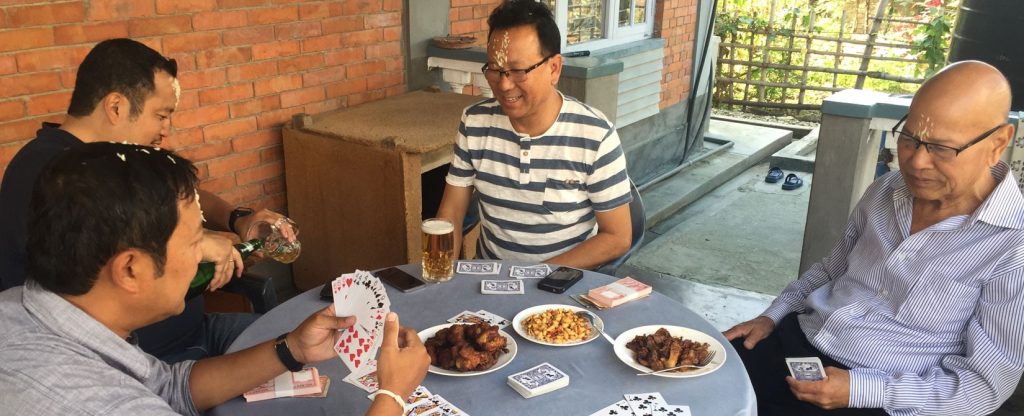
Dashain or Vijaya Dashami is the most significant Hindu Festival in Nepal. Dashain or Vijaya Dashami is the longest and most significant Hindu festival widely celebrated throughout Nepal. It is fifteen days in length; it falls on the bright half of the lunar month of Ashoj, which usually falls between September/October and ends on the day of the full moon. The Goddess Durga is worshipped in her numerous manifestations during the first nine days, known as Navratri, until the ninth evening – Navratri. A grand procession of idols representing various Hindu gods and goddesses is taken out in every village, town, and city on the tenth day to rejoice in the victory of good over evil. The remaining five days mark the celebration of blessings from the goddess to commemorate the victory. Like many religious festivals, Dashain involves many prayer (puja) rituals, generous offerings of exceptional food, fruits, animal sacrifices, and blessing from the family elders, followed by plenty of merrymaking. Navratri The first three nights are dedicated to Durga’s various manifestations, such as Mahakali, the goddess of divine power (shakti) and action; Parvati, a dedicated wife and mother; and Kali, the goddess of destruction. The next three nights are devoted to Mahalaxmi, the goddess of purity and wealth. The final three nights are dedicated to Maha Saraswati, the goddess of knowledge and arts. As usual, there are some mythological tales connected to this festival. The most common one is the victory of the gods over the demons. Despite this festival being celebrated to honour Durga, she is believed to have had all gods and goddesses’ collective strength to defeat the monster Mahisasura. The first nine days represent the fierce battle between Durga and the beast. Legend has it that gods were defenceless against the army of demons led by Mahisasura. So the gods were instructed to contribute a part of their divine prowess to form a new goddess to defeat the demons. Hence, Mahisasura Mardini’s formation – another name for this manifestation of Durga was devised with the combined might of 330 million Hindu gods and goddesses. Dashami, or the tenth day, is celebrated when Durga, combining power with the gods and goddesses, defeats Mahisasura. Rituals of the fifteen days Every single day of the fifteen-day festival holds its importance. Ghatasthapana is the first day of the celebration. Ghata or Kalash means “holy vessel,” and sthapana means to inaugurate. Kalash symbolises Durga covered and purified with cow dung, spruced up with flowers, and placed in a hallowed room where local terms are known as ‘puja or Dashain Ghar’ for prayer. Like most Hindu festivals in Nepal, cow dung is utilised to clean and paint the house and porch as it is believed to be holy and works as a purifier. A rectangular area is set aside to place the Kalash in the middle. Barley seeds, believed to be pure, are placed around the Kalash. In ancient times these seeds were brought from the bed of a holy river. The Kalash is treated as a representation of the goddess and is worshipped throughout the festival. On the day of Ghatasthapana, Shailaputri, another form of Durga, is worshipped. An oil lamp known locally as ‘diyo’ is lit throughout the Dashain until this festival’s final day. Hindus worship the Kalash during the evening and morning rituals. The rituals are either led by Brahmin priests or the elder of the household. These rituals are performed during auspicious moments; astrologers determine these moments. The ceremonies conjure the goddess Durga to reside within the Kalash. The Kalash and sand are sprinkled with water and are protected from the sun throughout Navratri. The barley seeds grow into five or six-inch tall wheatgrass called jamara by the tenth day. It is used on the day of tika to bless the family members by the elders. The barley seeds are sown in every household to keep them purest form during this puja. The wheatgrass symbolises wealth and prosperity, and the yellow ‘jamara’ is considered auspicious. The next phase of the festival that brings significant excitement comes with Fulapati, also known as Saptami – the seventh day of the celebrations. Fulpati, meaning sacred flowers and leaves, are collected for three days from neighbouring forests. The family members are not allowed to go inside the puja ghar from this day onwards. Instead, a unique ceremony occurs in Kathmandu valley when the jamara and Kalash used by the Royal family are brought from their ancestral home in Gorkha in a three-day march complete with military ceremony priests. Government officers dress in traditional attire while waiting for the arrival of pulpati on the route to join the parade to Hanuman Dhoka. First, the fulpati and the Kalash, including the jamara, are placed in the Royal Dashain Ghar. Then, the Nepalese army fires a gun salute as the sacred items are being set at the Hanuman Dhoka Palace as the Kings used to observe it – these days, the President of the nation witnesses this ceremony. Maha Ashtami is the eighth day when animal sacrifices occur in most Hindu homes throughout Nepal. An exciting practice used to be animal offering was offered alive to be left in the Goddess’ temple’s vicinity as an offering. However, some staunch Hindus fast today, and vegetarians offer vegetables such as radishes, coconuts, eggs, and calabash (bottle gourd) instead of animals. These days the families that make an animal sacrifice consume the meat during this festival. The following night is known as Kal Ratri. Hundreds of male chickens, ducks, goats, sheep, and water buffaloes are sacrificed in temples dedicated to Durga, the old palace, police, and army barracks throughout the nation. Most people in Kathmandu make their animal sacrifices at Hanuman Dhoka at Basantapur. All the courtyards are busy night and day during this period. Navami, or the ninth day, is the final day of the Navratri. This is the day when most animal sacrifice takes place. For example, Mahisasura is believed to have taken a buffalo
Trek to witness Chandras wedding

Chandra’s Wedding Trek Chandra’s Wedding Trek. Witness a traditional Rai marriage ceremony in Rural Nepal. Many of you know Chandra from trekking with him in Nepal or India or both countries and Tibet. Chandra comes from the Rai ethnic clan of Nepal. Their matrimonial practice is unique. When the bride and groom are to be with their families, they agree on the partnership and get engaged. Upon engagement, they start living together. However, it could be years or even decades before the final solemnization of their marriage takes place. Such a ceremony can be a massive burden financially to both the bride and groom’s families. They have to provide a free flow of alcoholic beverages (locally distilled or fermented); pigs and chickens are slaughtered to feed the guests for several days. Chandra’s marriage was solemnized on the 18th of February, 2018. Chandra and I have discussed opening up his wedding to be witnessed by our friends from overseas. This event will be a great cultural experience for those attending. Few foreigners have visited this part of Nepal as it lies off tourist/trekking trails. We sent the first and only trekker to this part of Nepal in October 2016. We have designed this package so you can see the real Nepal and experience a “once in a lifetime” cultural event. It will also be a great photographic opportunity to meet people who are not in Nepal’s tourist part. Part of the proceeds from this trip will go towards helping both families with wedding expenses. It is estimated that between 100 – 200 relatives and villagers will attend this wedding event on each side of the family – a substantial financial burden. Itinerary: 14/2/18: Arrive in Kathmandu to be met at the airport and transferred to the hotel. Well, well, arriving for the wedding on Valentine’s day… Hmmm. 15/2/18: Drive towards Patale on the border of Okhaldhunga and Solu Khumbu districts. We will be staying overnight in a basic lodge. 16/2/18: Drive for 3 hours or more, depending on the road conditions to the Inku River. We will start the trek to Chandra’s village of Majgaon, Pawei. The trek begins with a steep climb for about two and a half hours and turns into undulating terrain—4 hours of trek. You will be treated to a traditional Rai feast and cultural show in the evening. Overnight in a tent. 17/2/18: We will go for a short walk outside of the village. In the afternoon, lunch with Chandra’s immediate family, e.g., his parents, brothers, and their families – provided they are not preoccupied with the wedding chores. 18/2/18: Today, we will be part of Chandra’s family wedding procession to the bride’s village. They will play traditional musical instruments, drink, dance, and make merry on the way to the bride’s village. We will stay in the bride’s village for the night in tents. 19/2/18: We will witness some traditional ceremonies before leaving the bride’s village to return to Chandra’s home with much festivity. 20/2/18: We retrace our steps back to the road, head and drive to Phaplu, where there is an airport. 21/2/18: We take a short 30-minute flight back to Kathmandu. The rest of the day is free to wander around Thamel – the tourist hub of Kathmandu. 22/2/18 International departure. Cost US$1200 per person on twin sharing basis. Cost includes: Two nights in a 3-star hotel in Kathmandu with breakfast. Two nights in lodges outside Kathmandu with breakfast, lunch, and dinner. Six lunches and dinners when outside of Kathmandu. Drive to Chandra’s village in private jeeps. Tents while in the villages. Domestic flight from Phaplu to Kathmandu. Click here for our next wedding trek. Also, check out our Trekking packages for Nepal, Bhutan, India, and Tibet.
Bhutan, the People, Culture and Religion
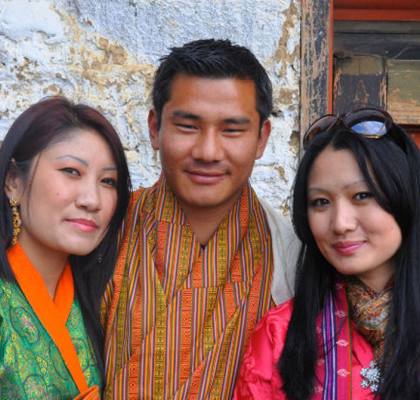
Bhutan, the People, Culture and Religion Bhutan had remained cut off from the outside world due to its remarkable geographical location. Part of this isolation was self-formed to protect its civilizations, unique identity, and independence from the rest of the world. The nation was observing strict segregation that tourism allowed foreigners to enter Bhutan from 1974. The Bhutanese mostly speak Dzongkha, Sharcop, the leading local languages, and Nepalese. The first two languages are linked to the Tibetan language, and the monks use the Tibetan scripture and language called Chokkey. The Bhutanese are similar to Tibetans and share distinct similarities in their arts, crafts, jewellery, and handicrafts. The Bhutanese and Tibetans both worship and revere Guru Padmasambhava or Guru Rimpoche. He was the tantric sage who introduced Buddhism into Tibet, which later followed into Bhutan. However, Bhutan’s people, culture, religious practices, and traditions have several distinct features. People of Bhutan According to a recent report in March 2017, Bhutan’s population is 789936 based on the United Nations estimate. They make up a mere 0.01% of the world population. Bhutan ranks 164 on the population list in the world. An estimated 40% of the population lives in the urban area, and the average age is pretty low at 27 years. Bhutan is sparsely populated in the mountainous and severely cold regions of the higher Himalayas and the arid tracts on the southern border with India’s Duars plains. The most populated areas of Bhutan are the fertile regions with the temperate climate of Central, Western, and South West (near the Indian border) The most populated Dzongkhags (administrative districts) are Thimpu, Chuka, Sarpang, Paro, and Phuentsoling, while Gasa remains one of the least populated Dzongkhags. Except for a few fixed roles based on gender, equality between females and males exists in traditional Bhutanese society. An excellent example of a selected function would be a man who works as a cloth maker while the woman is a weaver. Interestingly, both men and women work in villages, while in cities and towns, the man is the breadwinner while the woman is a homemaker. Arranged marriages do take place, but young couples choose their partners. Unions can be registered officially and sometimes involuntarily when the team has lived together for more than six months. Divorce isn’t uncommon at all; neither is it considered taboo. Both the government and the people of Bhutan give priority to education. It is accessible in Government schools until the higher secondary level, where students receive partial or complete scholarships depending on their merits. Once again, there is no disparity between the genders in education. The Bhutanese are a matriarchal society; the groom moves into the bride’s home after marriage. However, these days, most couples prefer to live separately on their own. Bhutan is a rare South Asian country that doesn’t practise the dowry system; the youngest daughter inherits her parental property (matrilineal). Women are not obligated to take on their father or husband’s name. Women also have no obligation to take on their father or husband’s name. As a result, polygamy and Polyandry are not uncommon. You will find many people with the same combination due to a limited selection of names in Bhutan. Sometimes they even use the name of their locality, village, or even their house for identification. There are fixed prayers and meal routines, and people observe the timings strictly. For example, the immigration off closes for thirty minutes precisely for lunch. Workingmen and women in offices or shops settle down to have their staple meal of ema datsi or rice around 2 pm. The honesty of the Bhutanese is what fascinates visitors to his nation. There have been cases where people got the shop owners have returned their lost belongings or extra money visitors paid. The Bhutanese are courteous to all visitors, no matter where they come from. Behavioural Code of Bhutan The Driglam Namzha is a formalized national dress and behavioural code. This code explains how the citizens of Bhutan have to dress and behave in public places. Driglam means discipline, regimentation, order, and custom, while Namzha means the system. The composite term implies The rule of regulation in behaviour. All citizens of Bhutan have been supposed to follow the Driglam Namzha since 1990. Cleanliness is taken very seriously by the Bhutanese Government, and they have initiated a series of rules and regulations to uphold the value of cleanliness and orderliness in the country. However, one can see the stark difference between the Bhutanese and Indian administrative systems in the border town of Phuentsoling and Jaigaon. The noisy, dirty ambience of the Indian border town of Jaigaon is a sharp contrast to the clean and orderly city of Phuentsoling in Bhutan. Some signages encourage the practice of cleanliness in every central public place, including roads and areas of interest. Streets are regularly swept, and public toilets and all tourist places of interest are kept clean by the government. Dress Code Bhutanese men dress up in a knee-length robe that is tied at the waist with a belt. This dress is called Gho, whereas the women wear colourful blouses with a large rectangular cloth tied at Kira’s waist. In addition, the women often wear a bright brocade jacket over the blouse. All Bhutanese follow this dress code for official visits, occasions, public ceremonies, and festivals. Religion Buddhism is the principal religion of Bhutan, and it reflects clearly in all domains of life there. Household items and utensils have religious symbols; prayer flags fluttered on hills, roads, bridges, and trees. Religion here is a way of life that surrounds their lives. You will observe that almost all roofs have a slight white prayer flag fluttering on top. This indicates that the owner has offered to the local deity for appeasement. Each district of Bhutan is known as a Dzongkhag, consisting of a Dzong (Fort) with massive walls that serve as a religious and administrative hub. Apart from a monastery and prayer hall, these Dzongs have chambers of justice,










